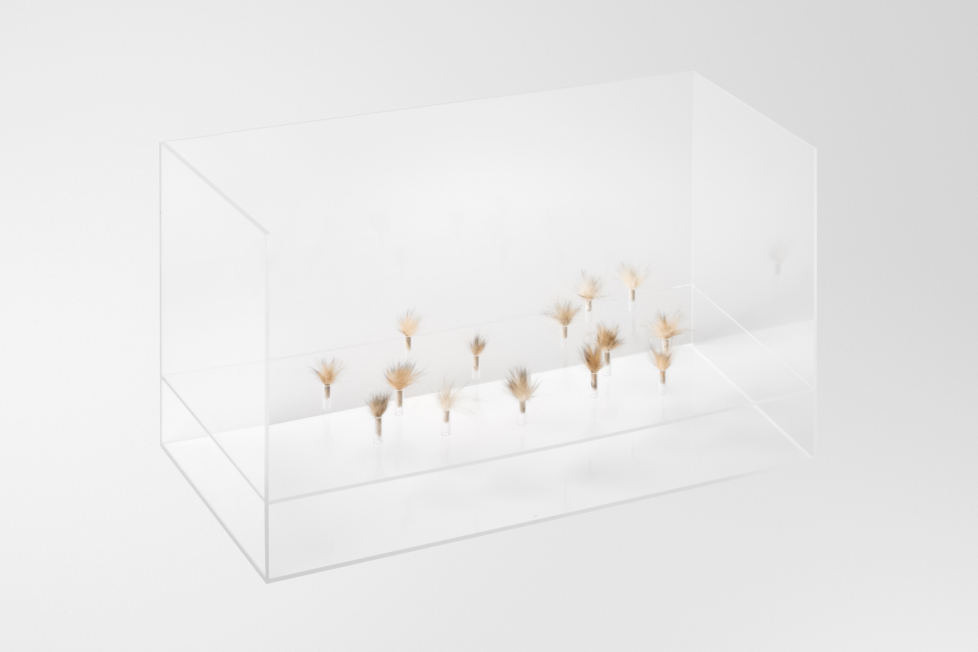
An established gallery in Copenhagen, Denmark, just opened a group show featuring seven women and zero men. While such events ought to be neither rare nor spectacular, they sadly are. But the truly incomprehensible discovery is that 22 out of the 24 artists represented by the gallery are men. By rights, this text ought to be about nothing else.
It should not be about how Nils Stærk, a high-ceilinged, concrete-floor-and-white-walls gallery on the front lines of gentrification in Copenhagen’s Northwest District forms the backdrop of the exhibition Betamax, whose juxtaposition of seven artistic practices creates “a collective pattern of movement, pointing back, forward, and sideways.” Works by Haegue Yang, Charlotte Brüel, Iulia Nistor, Rebecca Lindsmyr, Tove Storch, Lea Porsager, and Sonia Landy Sheridan make up this so-called pattern of movement, but this text should not be about how that pattern is difficult to spot.
It should not be about the opaque exhibition concept, about the non-connections between the technology-fetishising title and the actual space, which in fact comes across as pretty organic with Brüel’s feathers, Yang’s yarn and cones, and Porsager’s erogenous zones (their industrial origins are thoroughly shattered, and without going too far along a single tangent of interpretation, this destruction is presumably an essential trait of the work). Again and again, my encounters with exhibition texts and concepts tend to involve repeated nagging doubts: are my faculties of comprehension unequal to mastering the level of abstraction required for a proper reading, or do the sentences actually say nothing? This occasion is no exception. For example, one statement about the different modes of expression found in the seven practices points out that “With their individual experience, they represent different contemporary impressions.” Well, yes. Surely, that is what being a person and doing things at a given time means.
But this text should not point fingers at the writing of others; it should point fingers – countless ones – at how Porsager and Storch are the only women artists on the entire Copenhagen, Nordic, international art scene who have made it through the eye of a needle into the thoroughly entrenched men’s club that is Nils Stærk’s gallery. This text should not be about the fact that it seems curatorially uninspired (and very commercially astute) to re-enact the Porsager concept which, only six months ago, took over the city’s most important exhibition venue to genuinely majestic effect. Of course, the wind turbine blades come across differently in the gallery context; they have other cuts, and the blade slices are installed as delimited images and sculptures rather than the pierced, yet massive being they formed at Kunsthal Charlottenborg. Also, this text should not criticise good works.
It should not criticise how, in this context, Yang’s sculpture feels strangely detached – a rather soft and warm little yarn tree between Storch’s almost demonstratively minimalist steel rods and Landy Sheridan’s strangely graphic-designer-y and analogue-core photographs (incidentally, these photos constitute the exhibition’s only visible concession to the camera vibes, which, thanks to the exhibition title, affects the space way more than what its paintings and sculptures can actually carry). Yang is a well-established star in the art firmament, represented by Greene Naftali and kurimanzutto, among others. And while there is no reason to second-guess motivations, the inclusion of this deliciously tactile object of desire in a gallery exhibition just a few weeks before the National Gallery of Denmark opens the country’s extensive and first-ever solo show of Yang’s work is, if nothing else, noteworthy.

However, this text should not be about the presumed intentions of the curator (and gallery director), who after all did invite a group of women into a space and shop in which they, with the exception of two, are not really wanted. It should not be about how the exhibition is at best well-meaning if uninteresting in its cryptically worded ambiguity about what it really wishes to present, at worst a concerted attempt at simulating a momentary, understated intersectionality to cover up the fact that the gallery’s actual gender balance is grotesque. It should not be about material fragility or about the potential poetry of flowers and feathers and pink, for turning one’s eye attentively to the works themselves would be to close those same eyes to the systemic reality that Nils Stærk (and almost all other Copenhagen galleries) prefer to sell art by men.
This text should be solely about the fact that no single exhibition impulse, no matter how feminist, can alleviate the ridiculous fact that a powerful actor within a scene – the art scene – that has for centuries allied itself with progressive, critical potentials, now props up a case of gender inequality of Victorian proportions in 2020s Denmark. And by “ridiculous,” I mean laughable and deeply harmful and ignorant beyond all bounds.
Hopefully, texts will not have to be about this for much longer; hopefully, the for-men-by-men market will soon be a thing of the past; hopefully, the gallery will be suitably punished by buyers, leaving its owners alone in the renovated warehouse premises they don’t deserve, trying to sell heavy steel and abstract expressionism to the future old men of Vesterbro.













